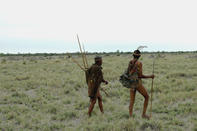Hunter-Gatherer Life
At different times and places, San-speakers have lived in various ways; the Kalahari San are not necessary typical of all San and, even in the Kalahari groups, lifestyles may differ. Nevertheless, studies of Kalahari groups, for instance the Ju/'hoasi and the G/wi, create a general picture of the hunter-gatherer life.

A division of labour between men and women is central to the economy. Plant foods are the dietary staple, and women, the chief gatherers, have expert knowledge of the veld: they know when and where resources such as melons, tubers, corms and berries are to be found. Women also collect or snare small fauna (such as reptiles, birds and small antelope).
While out collecting, they may observe the movements of the game and relay this information to the hunters. Men may gather food too, especially in the low hunting season. Gathered foods are distributed among the gatherer's family, while the larger game hunted by men gets distributed among the whole group.
The formidable reputation of the San as expert hunters is due to their outstanding tracking abilities and their ingenious hunting techniques. San trackers can follow spoor across virtually every land surface, even pursuing a wounded antelope among the spoor of a whole herd, until it finally leaves the herd and dies.
Hunters use bows and arrows tipped with poison (derived from beetles or snakes) which does not contaminate the meat. However, it usually takes time before the poison works, allowing the dying animal to flee from its attackers, sometimes over considerable distances, making skilled tracking essential.
San Hunting Skills
San arrows are clever instruments of death. Today, as in earlier times, they consist of four components. The point used to be made of bone or small skillfully flaked stones; today flattened nails or pieces of wire are used. The point is fitted into the 'link', which is tapered at either end and held in place by a reed collar.
The link is fitted to the shaft in such a way that, when the arrow strikes its target, the impact breaks the link free from the shaft, reducing the likelihood of the head working loose, as there is less weight hanging from it. This also means that the animal cannot easily dislodge the point by rubbing against a tree.
The poison is applied just behind the point, and the arrowhead has to stay in the animal for some time to ensure that the poison is adequately absorbed into the animal's system. The man who owns the arrow that killed the animal has the privilege of distributing the meat, according to rules of kinship, ensuring that everyone receives a portion. Sharing and the relative equality of all group members are important features of San societies.
Though San groups did not have political chiefs, leadership was certainly recognized, according to seniority and ability. In traditional San societies, the husband went to live with the bride's parents on marriage. There were many rules of respect to be observed between the couple and their respective in-laws, whereas those separated by a generation (such as grandparents and grandchildren) were permitted a 'joking relationship', in which less formal conduct was appropriate. The San are known for their marked fondness for and indulgent attitude to children.
Typically, the group would split into smaller family units seasonally (usually when water and food were at their most sparse and dispersed), re-uniting at a later stage. Formalized gift giving, called hxaro by the Ju/'hoasi, is a way of maintaining reciprocal relationships between friends and relatives both in and beyond the group. This creates a web of support and access to resources over large areas. The importance of San kinship systems is echoed in religious beliefs, in myths and stories, and, obliquely, in their rock art.